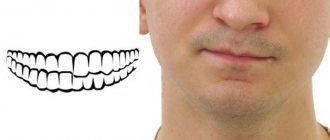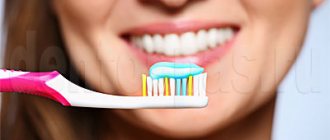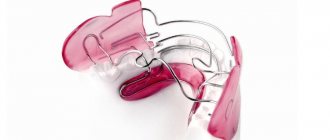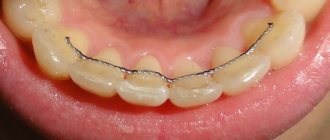Aligners and braces are used to correct bite pathologies. When choosing between these two orthodontic systems, many factors should be taken into account, the main of which are medical indications. We will compare braces and aligners based on several parameters: comfort, aesthetics, efficiency, etc.
In this article
- How do braces differ from aligners: design features
- Aligners or braces: treatment effectiveness
- Wearing comfort and adaptation
- Aesthetic factor
- How to eat with braces and aligners
- Rules of care
- What is more expensive - braces or aligners?
Typically, after an examination and diagnosis, the orthodontist offers the patient several treatment options. What to choose for bite correction - aligners or braces? Let's compare these orthodontic structures according to the following parameters:
- design features;
- effectiveness of treatment;
- aesthetics;
- wearing comfort and adaptation;
- supply system;
- rules of care;
- price.
Let's look at these characteristics and find out which is better to choose - aligners or braces.
What are aligners
Description
Aligners are one of the most worthy alternatives to traditional braces. Since they are made of durable and hypoallergenic material, they can be used even in childhood. As a result, the smile becomes healthy and beautiful without the slightest harm to health.
Aligners are special orthopedic structures that can be removed and put on independently. They are used to correct existing malocclusions, as well as to straighten one or more units of the dentition. Externally, the aligners are very similar to the mouthguards used by professional boxers.
Action
How does the teeth straightening process occur? It's all about the pressure exerted on the teeth. Under pressure, the alveolar tissue begins to soften and dissolve, which allows the teeth to gradually move relative to each other.
Unfortunately, it is not possible to correct too severe curvatures and bite pathologies with the help of aligners. This is because the pressure applied is not too strong compared to, for example, braces. However, in most cases, aligners do their job perfectly well.
Braces
The braces system is a non-removable orthodontic device consisting of the braces themselves - clasps that are attached to the teeth, arches connecting them and retaining elements such as ligatures. The history of braces goes back over a hundred years. Initially, this orthodontic design looked quite cumbersome and was intended for the treatment of simple dentoalveolar deformities - for example, correcting the location of slightly rotated teeth or eliminating small gaps between them. However, over time, specialists managed to bring the design of braces to perfection, making it possible to correct almost any curvature with their help, from uneven teeth to serious anomalies of the dentition and jaws.
There are: ceramic braces, metal braces, sapphire braces.
Pros and cons of braces
- Braces can correct almost any orthodontic imperfections: some bite pathologies and absolutely any curvature of the dentition. There are few contraindications to wearing systems and almost all of them are associated with rare individual characteristics of the patient.
- Orthodontic structures can be installed at any age: this is especially important for adults who want to correct bite pathologies. All that matters is motivation and the ability to wait for results.
- The ability to form a beautiful, natural smile: changes for the better can be noticeable in the first weeks after installing braces, but in general they allow you to achieve the correct position of your teeth and a beautiful smile.
Indications for treatment with braces
- Anomaly of individual teeth. If among the even dentition there are only a few crooked teeth, then external or internal braces will correct this small drawback.
- Anomaly of the entire dentition during its formation. Children often experience crookedness of several teeth at once. In especially severe cases, the entire dentition is deformed.
- Malocclusion during the period of its formation. Malocclusion is characterized by the teeth of the upper or lower jaw intersecting each other. If the bite develops incorrectly, then children must be examined by an orthodontist.
- Preparing the oral cavity for implantation or prosthetics. When one or several teeth are missing in the dentition, there is a danger of developing a malocclusion. In this case, the lost tooth must be replaced with an implant or denture.
- Profile correction (improving aesthetics). Teeth that protrude forward are corrected by wearing turnkey braces.
- Removing unerupted teeth. Some teeth, such as third molars (wisdom teeth), may remain invisible in the gum. This occurs due to the small size of the jaw or too closely spaced teeth.
How teeth are straightened with aligners
Consultation and impression making
First of all, the patient needs to go to the clinic for consultation with a specialist. After a thorough preliminary examination and tests, the doctor makes his conclusion about the presence of inflammation and caries in the oral cavity that needs to be eliminated, or immediately proceeds to the next stage.
Next, the doctor offers the patient several treatment options and talks about all the nuances. After this, it is necessary to make an impression of the jaw, according to which a set of aligners will be made.
Making a set of trays
Since the treatment process with aligners is long, you will need from 10 to 40 drops. They are produced in a special laboratory. As a rule, this takes about 2-3 weeks after the impressions are taken. After this, the patient is invited to the clinic to install the first pair of aligners.
At the impression taking stage, modern 3D modeling is used. This technology is as accurate as possible, which allows the treatment to be effective and achieve the desired results in the shortest possible time. The aligners should be changed every few weeks; the patient can do this themselves right at home.
Duration of treatment
Of course, it is impossible to say exactly when a particular defect will be corrected. It all depends on the complexity of the pathology and the patient’s compliance with all doctor’s instructions. In addition, the quality of the materials used in the manufacture of aligners also influences the final result.
You need to wear the mouth guards for at least 22 hours a day, removing them only when eating and brushing your teeth. The period for correcting a bite is different for each person, on average from 4 to 17 months, subject to all the dentist’s advice. In rare cases, treatment can take up to 2 years.
Consolidate the result
Throughout the entire treatment period, it is very important for the patient to periodically visit his doctor. At the appointment, the doctor will be able to evaluate the result already achieved and monitor the absence of inflammation and other problems that may hinder the achievement of the goal.
After treatment with aligners is completed, the specialist may prescribe another design called a retainer. This will allow you to preserve and consolidate the result without the risk of teeth moving to their previous position. The period of use of the retainer is from 1 to 4 months.
Manufacturing process
The orthodontist takes photographs of the patient’s face (several angles), photographs of dental units in various projections, and makes impressions of the dentition according to the manufacturer’s rules.
Collected information, including photos, x-rays. The pictures are sent to the factory that makes the mouth guards. Workers study the documents and, if necessary, adjust the plan.
The company produces aligners using two methods:
- scan the impression, convert it into a three-dimensional sample, or create a changing model;
- The 2nd method is characterized by accuracy. The program calculates the line of movement of the dental units at the calculated location and time required to move the dental units to the required distance. A mouthguard is made for each stage.
Aligner appearance and material
Silicone
Currently, two material options are used for the manufacture of aligners, each of which has its own advantages. Silicone is great for correcting minor pathologies. It can be used to produce both thermoplastic (universal) and individual mouth guards.
The only drawback of using silicone is the rather noticeable final thickness of the product. Because of this, the patient may feel slight discomfort while wearing it. In addition, in rare cases, there is a slight violation of diction, which is why a person feels insecure while communicating with the interlocutor.
Polyurethane
Aligners made of a material such as polyurethane are distinguished by their reliability and durability, even under strong mechanical stress. Such products are ideal for children and teenagers who do not always handle removable structures carefully.
Another advantage of a polyurethane mouthguard is its minimal thickness, which is why it is practically invisible on the teeth. Wearing such designs is very comfortable; they do not cause inconvenience and do not affect pronunciation. At the same time, the cost of treatment will be slightly higher, which is fully justified by the positive properties of the mouth guard.
Differences from braces
If we compare dental treatment with aligners and braces, the former have many advantages. The material is hypoallergenic, so it is suitable for absolutely everyone. The surface of the product is smooth and soft, which avoids irritation and injury to the mucous membranes.
Aligners, unlike fixed orthodontic structures, can be removed. This simplifies oral care, resulting in a reduced risk of tooth decay and other diseases. The main difference is the aesthetic factor. The aligners are not noticeable on the teeth, so they do not affect the patient’s appearance in any way.
Types and installation
Aligners come in several varieties. More expensive versions of mouthguards are made taking into account the individual characteristics of a person’s jaw structure. This allows you to achieve guaranteed results in the shortest possible time. However, the manufacturing of the aligners itself in this case requires more time.
Another option is thermoplastic systems. They are suitable for everyone, as they can take the desired shape under the influence of high temperature water. In addition, aligners vary in the time of use: some should be worn all day, others only at night. They also come in different sizes: for adults and children.
What type of orthopedic construction should you prefer?
Both correction options have good reviews from specialists and patients. However, sometimes only braces can correct the pathology. In this case, there is no question of choice. But, if the orthodontist offers both options, the choice is up to the patient.
Responsible patients who will remember to put the aligners on after meals and will wear them constantly can choose clear and more attractive aligners. But, if there is no such confidence, it is better to install a brace system that cannot be removed independently. Which will provide a guaranteed result.
Also, when choosing, the cost of the treatment course is also important. Correcting an overbite with braces is much cheaper.
The patient's choice may also be influenced by the need for hygiene procedures. Using a brace system requires the purchase of special care products, the list of which includes an orthodontic toothbrush, brush, mouthwash, mono-beam brush, and irrigator. Of course, it is not at all necessary to purchase everything at once, but it is important to keep the oral cavity completely clean so that leftover food does not lead to the appearance of bacteria. The mouthguards are easy to care for.
Orthodontic correction requires high professionalism and good training from doctors. These are the qualities possessed by the specialists of the Sanident dental clinic, which provides services in the urban district of Ivanteevka and Shchelkovo. For diagnosis and treatment, we use advanced equipment, which allows us to obtain good results in the treatment of a wide variety of dental pathologies.
A transparent pricing policy gives patients the opportunity to receive the highest quality treatment at affordable prices.
Specialists at Sanident comprehensive dentistry will perform dental correction as comfortably as possible for the patient. We guarantee an individual approach.
Straightening teeth with aligners without pain
Adaptation
As a rule, a person gets used to aligners installed on their teeth very quickly and painlessly. There is no discomfort and no problems with speech. In rare cases, the patient may notice irritation of the gum tissue or an unpleasant taste in the mouth.
In any case, all minor inconveniences disappear within a few days and do not require seeking help from specialists. Today, aligners are considered the most comfortable, aesthetically attractive and safe systems for treating malocclusion in people of all ages.
Advantages and disadvantages
One of the key advantages of correcting malocclusions with the help of aligners is that they are invisible to the interlocutor even upon closer examination. In addition, dentists themselves claim that mouthguards are the least traumatic and most convenient system to use; they do not irritate the gums and inner surface of the cheeks, and do not cause allergies.
The only minor drawback is that the aligners should be removed before each meal and brushing your teeth. However, this greatly simplifies their care and helps prevent the occurrence of caries. Also, in case of severe pathologies, a large number of replacement trays may be required, the cost of which is quite high.
Wearing comfort and adaptation
Braces cope more effectively with severe malocclusion pathologies, but in many other respects they are much inferior to aligners. Thus, it takes longer to adapt to orthodontic braces than to aligners. Immediately after installing braces, patients complain of pressure, pain and discomfort in the oral cavity. Some patients experience rubbing of the oral mucosa in the cheeks, lips or tongue. The adaptation period to braces lasts from 5 to 15 days.
People get used to mouth guards faster. They do not cause pain and do not rub. The patient just needs to get used to the presence of a foreign object in the oral cavity.
Contraindications
When should you not wear aligners?
Fortunately, there are few contraindications to wearing aligners to straighten teeth. This includes easily removable problems such as the presence of hard plaque and stone on the surface of the enamel, as well as inflammatory processes in the oral cavity.
It may also be difficult to take impressions of the jaw and wear a mouthguard if the patient has serious mental disabilities. If the doctor, during the examination, reveals the presence of impacted or only partially erupted units on the surface, treatment with aligners may also be difficult. Some teeth may need to be removed first.
When are aligners needed?
Invisible aligners can help treat a variety of oral problems. This usually includes mild crowding or, conversely, sparseness of the row, the presence of a gap between the front teeth, the wrong direction of growth or rotation of individual teeth in relation to the rest.
Also, wearing an aligner can be prescribed as a preventive measure or after removing braces - a system for consolidating an existing result. They can be used for remineralization of enamel, as well as for whitening with a special gel.
Indications
There are many dental anomalies that can be successfully corrected by aligners:
- three (gaps) between the teeth, between the incisors, they are called diastema;
- crowding of dental units, “climbing” and rotation around its own axis;
- mesial, distal, cross, direct and open bites;
- if necessary, free up space for implantation;
- consolidation of the correction result with a bracket system.
It is important to know that aligners eliminate minor anomalies of the dental system.
Recovery after teeth straightening with aligners
Care during treatment
Each patient must understand that he has a great responsibility. After all, the final result of treatment depends on proper oral care while wearing aligners. You should clean not only your teeth, but also the aligners themselves. This should be done before each use (ordinary water will do), and also once a day using the paste.
It is important to understand that aggressive detergents cannot be used to wash products. This can lead to disruption of the integrity of the mouthguard, its deformation and loss of strength. At best, the treatment will be ineffective, and at worst, additional health problems will appear.
Prevention
After completing treatment with aligners, you should definitely see your treating specialist. Only he will be able to correctly assess the result of the work done and, if necessary, prescribe additional measures.
In addition, even if the patient is completely satisfied with the result of treatment, he should visit the dentist at least once every 6 months. This will allow even minor deviations to be identified as early as possible and appropriate treatment to be prescribed. To prevent re-displacement, you can wear mouth guards every few weeks.
Advantages
The popularity of the aligner correction method is explained by the following factors.
- Convenience. The mouth guards are easy to use and can be quickly removed and put on.
- Aesthetics. The product is invisible on the teeth.
- Safety. Does not damage enamel. The aligner is made without sharp corners that damage gums or tissue. The material is controlled for safety.
- Reliable fastening. The structure is made to order and fits tightly to the dentition.
- Easy care. The system is washed with warm water and the plaque is cleaned with a toothbrush.
- If desired, the design will whiten teeth or strengthen tooth enamel. All you have to do is fill the aligners with the appropriate medication.
- The material does not change color during wearing.
Before and after teeth straightening
Communication without complexes
Wearing aligners is an excellent option for correcting malocclusion pathologies for those whose lives involve constant communication and negotiations at work. Their use is especially relevant for public figures, politicians and pop stars. Mouthguards are not visible to others and do not cause problems with diction, so no one will know about their existence.
With the help of these transparent products, you can correct the position of your teeth in a row, remove gaps between teeth, and even give your face a more correct anatomical structure. A beautiful smile will give you self-confidence, will endear you to any interlocutor and will help you overcome embarrassment.
First result
You can achieve visible results if you follow all the doctor’s instructions after just a few months of wearing the aligner. Many patients immediately quit treatment because they are already satisfied with the effect, but this should not be done.
If you stop at this stage, the teeth can easily return to their original position, then all procedures will have to be repeated. The full course lasts from 2 to 18 months, depending on the complexity of the curvature. The aligners should be changed according to your doctor's instructions every 1-2 weeks.
Therapeutic effect and result
Each aligner is replaced with the next one from the set every 2-3 weeks. During this period of time, subject to the wearing regime, it moves the teeth in accordance with the treatment program.
Aligners allow you to move teeth in a transversal plane (right/left, inward/outward), perform tooth rotation and body movements. However, this type of orthodontic treatment is limited in the movement of teeth in the vertical plane (up/down), for this reason this type of treatment is not suitable for patients requiring verticalization.
Cost of aligners for teeth straightening in Moscow
The cost of treatment with mouthguards depends on several factors: the manufacturer, the material used, the complexity of the disorders and the required number of products in the set. In addition, additional procedures may be required during the recovery process, for example, eliminating caries or gum inflammation.
The Kingdom of Smiles Clinic offers the highest quality materials; all services can be paid in installments without interest. Sign up for a free consultation at a time convenient for you, our specialists will be happy to answer all your questions.
| Service | Cost, rub. |
| Ultrasonic cleaning of the oral cavity | 4500 |
| Taking an impression with silicone, 1 jaw | 1000 |
| Retention mouthguard | 7500 |
| Making a set of trays | From 80000 |
previous post
3D computed tomography of teeth in Moscow
next entry
Rules for wearing Invisalign aligners
The number of aligners required for a course of treatment individually depends on the complexity of the defect required to be corrected. The minimum number of mouthguards that allow you to correct the bite is 10, the maximum is 40. One mouthguard is designed for use for fourteen days. After this, you need to move on to using the next mouthguard. And so on for each mouthguard from the complete set, for an effective course of treatment.
The Invisalign aligner is very easy to install. First, it must be rinsed under water, then with a gentle movement, fix it on the dentition. The kappa itself will take its right place. The convenience of aligners is that they do not create problems in pronouncing sounds. It is recommended to remove the mouthguard when eating to avoid deformation of the mouthguard under the influence of hot or too hard food.
What does the cost depend on?
The final amount of correctional therapy is always individual, because it largely depends on the severity of a particular clinical case. The more complex the defect, the more copies of the tray will need to be made. In addition, you should take into account the cost of hardware diagnostics and an initial consultation with an orthodontist. It is worth remembering that the funds invested in correcting your child’s bite will be repaid by the results obtained: healthy, beautiful teeth and an attractive smile.
The network of dental clinics “Smile” offers services for correcting bites in children and adolescents using Invisalig aligners. We provide our patients with a bonus - installment payment (no interest), as well as a family discount. If necessary, we issue the necessary documentation for processing personal income tax deductions.
Our orthodontists are highly qualified and have extensive practical experience. Specialists improve their skills, raising their professional level in advanced orthodontic centers in Russia and Europe. The level of our services meets international standards.
The clinic's branches in Moscow are within walking distance from the metro:
- near the station Alekseevskaya (area of VDNH and Mira Avenue), address: st. 3rd Mytishchinskaya 3, building 2;
- not far from the station Shelepikha, address: Shelepikhinskaya embankment, address: 34, building 1.
Bring your children to our dentistry, we will correct the bite comfortably. A child’s joyful smile is the main reward for doctors.
What is included in the diagnosis
Preliminary diagnostics in our clinic are performed using high-precision imported X-ray equipment ORTHOPHOS XG. This stage is necessary to identify indications and contraindications for occlusion correction using aligners.
The second stage of diagnosis is making individual impressions or scanning with an iTerro device, which allows you to create a 3D model of the jaws. Based on this model, personal mouth guards will subsequently be manufactured in production in the USA. When using this technology, there is no need to make physical impressions.
Based on the data obtained, a step-by-step therapy algorithm is developed using special software. ClinCheck technology allows digital interpretation to predict the progress of defect correction and visualize the final result. It should be noted that our clinic’s specialists are certified to use Align Technology products.
System price
It is important to remember that the cost of teeth correction with a system (excluding the technical part) may vary depending on the specific case, the complexity of the treatment, its duration, etc. Typically, the cost of the Invisalign braces system is comparable to the cost of traditional braces and in our dental clinic ranges from 70,000 rubles. Only an orthodontist can determine the exact cost of treatment because it depends on your individual needs and treatment plan. You can get advice by ordering a call from the website.
| Correction of teeth with the INVISALIGN system (excluding the technical part) | from 70,000 rub. |
More details by phone: +7,, +7 (499) 730-33-88.











